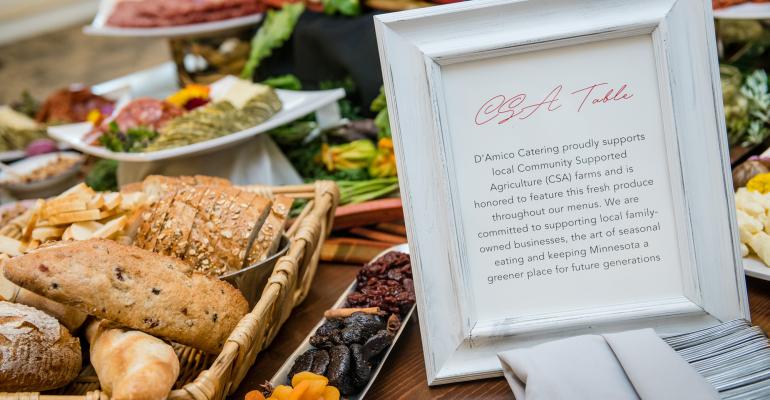They’re found far north in Arctic snow and deep down in the sea. What are they? Tiny pieces of plastic, a fact that has alarmed people around the world.
Many off-premise caterers are rising to the challenge of reducing single-use plastics at their events, turning to a wide range of options.
Off the menu: plastic utensils for guests. “We use either a fully compostable plant-based utensil line or stainless steel utensils that get washed for all of our events,” says Alison Awerbuch, chef and partner with New York-based Abigail Kirsch.
Other single-use plastic pieces that are falling by the wayside include plastic straws—now switched out to paper straws—and plastic cocktail stirrers. The team at Atlanta-based Affairs to Remember puts plastic cocktail stirrers under the bar, providing them only upon request, says Ahmad Nourzad, executive chef. The team is now sourcing paper cocktail stirrers.
BETTER THAN BOTTLES A major single-use plastic item disappearing from caterers’ menus: individual water bottles.
Here, beautiful “water stations” come to the fore. “We suggest that we add ‘hydration stations’ or ‘water stations,’ where we utilize large glass drink dispensers of various waters and beverages for guests to refill their own cups,” explains Robin Selden, managing partner/executive chef of Stamford, Conn.-based Marcia Selden Catering and Event Planning. “Of course, there are always occasions where this is not ideal for a specific style of event, but it has proven to be a great alternative when the opportunity allows and most definitely reduces the use of disposable water bottles.”
Registration is now open for The Special Event 2020, co-located with Catersource, March 9-12 in Las Vegas. Click here for more information or to register!
If client demands a single-use personalized bottles, Abigail Kirsch has a solution: “We offer our clients the option of purchasing reusable aluminum water bottles—logo’d is an option—through us,” Awerbuch explains. “Guests can use these at filling stations during the event and then take the bottles home with them.”
MOVING FOOD Keeping food safe during transport is a huge responsibility, and a challenge in going green.
“We cover platters of prepared food for transport--that plastic unfortunately going to a landfill--although we continue the search for a recycling solution,” Affairs’ Nourzad explains. “However, when we wrap rolling racks of prepared food, we wrap them in compostable clear wrap. It’s single-use, but it doesn’t end up in a landfill," he notes. "We’ve explored vinyl rack covers, but being a 100 percent off-premise caterer producing hundreds of full-service events every year, [the covers] would frequently end up in landfill because of wear and tear. Thus the decision to go with compostable wrap.”
Indeed, one of the toughest single-use plastics to banish is plastic film, caterers say, which is nearly impossible to recycle. Plastic film is the “bête noire of foodservice,” says Richard Mooney, CEO of Los Angeles-based Kensington Caterers. “It is a lifesaver, but we all overuse it.” When the Kensington team turns to foil pans, they wash and re-use them.
By Word of Mouth Catering in Nedlands, Western Australia, relies on reusable plastic tubs and lids as often as possible to transport food. Also, “We have done away with single-use chafing dish inserts and only use washable metal and ceramic ones,” says spokesperson Enrika Brianskyte-Sher.
NOT SO GREEN Some “green” options sound greener than they are, caterers warn. Recyclable bottles, for example, cannot be recycled if the event site offers only trash bins but not recycling bins.
This hurdle isn’t stopping D’Amico Catering of Minneapolis. Even if the venue doesn’t offer recycling bins, “We bring special recycling bins with us for off-premise events, and have them in house at all times,” explains Rachel Bruzek, design and culinary manager. The company also uses a tried-and-true method to keep kitchen scraps out of the trash: “Our kitchens use pig buckets for food scraps,” she says.
The majority of caterers interviewed for this article say their own companies are committed to “green” practices such as reducing single-use plastics. For some, clients are partners in the effort. Yet a few caterers say their clients are more concerned with cost than anything else.
MONEY MATTERS “Many clients focus on cost savings rather than the greater good of going green,” says Susan J. Stalnaker, co-owner of Catering by Robert/Event Concepts, based in Tampa, Fla.
Mooney says he sometimes has to guide clients to a greener event. “I would say we suggest the green approach much more than clients do,” he says, “at least twice as often.”
Yet the team at Affairs to Remember says that going green leads to the long green—revenue, that is. “We do have some clients who require green practices. However, we’ve garnered hundreds of thousands of dollars in revenue in new business just based on our having such a strong sustainability program, which we call ‘Legacy Green,’” Nourzad says. “We’ve had potential clients at our facility for a get-to-know-you lunch and the moment they learn about our ‘Legacy Green’ program, they decide to contract with us.”
Coming next: In Part 2 of this feature, we will share success stories caterers share in going green. Watch for it in Special Events Eventline.





